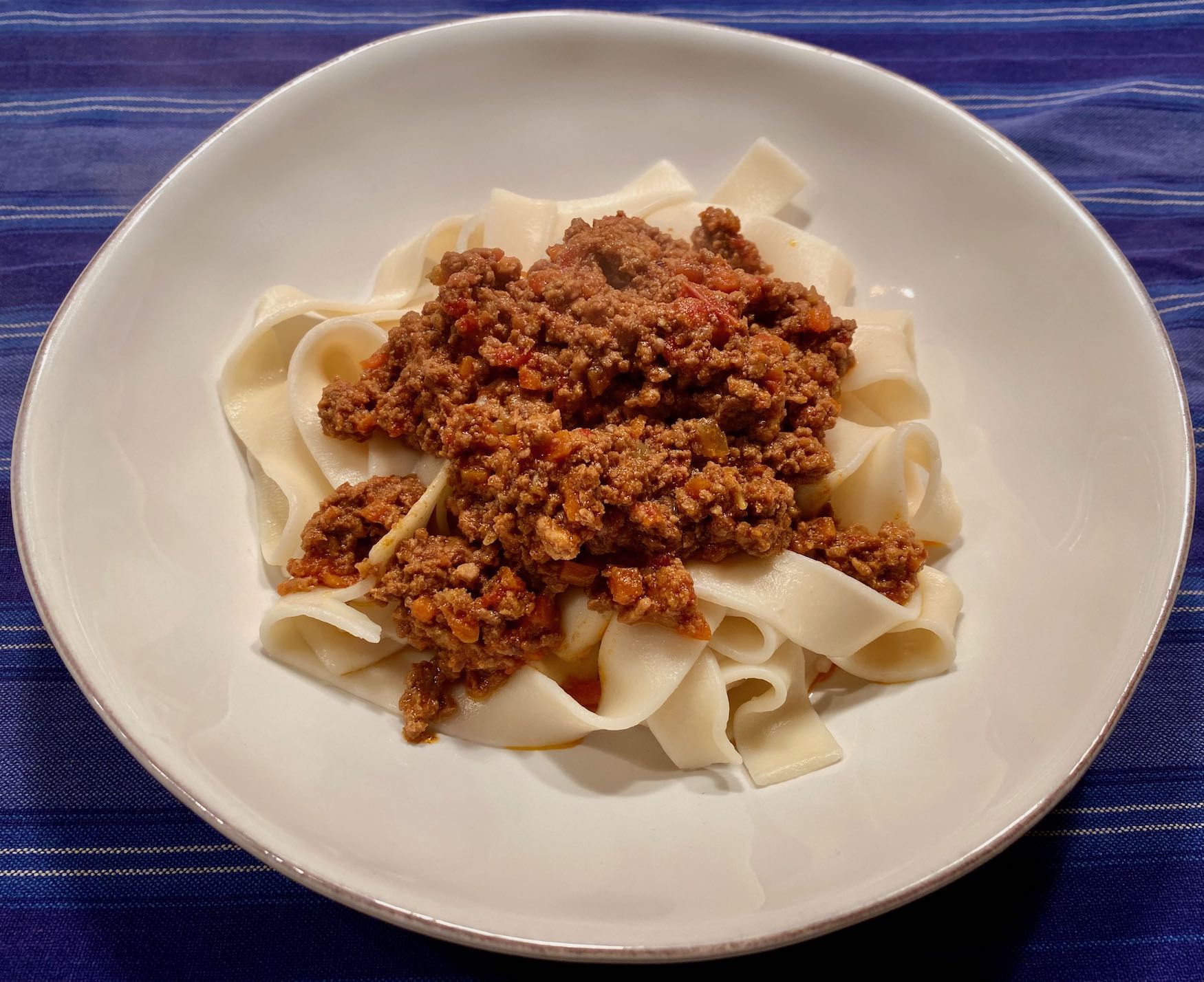
Pasta with a Bolognese meat sauce is one of fall’s perfect meals and this recipe is perfect every time I make it. This recipe alone makes fall’s arrival something to look forward to.
I use Marcella Hazan’s Bolognese recipe (she calls it Bolognese ragù). Hazan has a beef and pork variation Bolognese recipe that is delicious! Simmering the meat in milk makes it very tender. Cooking the sauce for hours creates a thick, rich, flavorful topping for pappardelle or the pasta of your choice.
It turns out that the technique for making Bolognese is controversial. Everyone has a favorite (see these articles in Serious Eats and The Guardian).
In years past, I’ve used a Bon Appétit recipe and also borrowed ideas from The Silver Spoon recipe (Phaidon). That said, Hazan’s recipe is so good, I might be a Hazan Bolognese loyalist.
Hazan’s recipe is from Essentials of Classic Italian Cooking. I was fortunate to get a used copy at my local used bookstore for $5.00. If you want to explore all of her great recipes, you can get a used copy here (Thriftbooks).
Set aside your afternoon. The recipe involves several hours of simmering. I guarantee that you’ll enjoy the aroma so much, you won’t mind hanging around the house while it cooks.
This recipe will make 2 1/2 – 3 cups of sauce. With the pasta, this makes 4-6 servings.
Tips
- The recipe calls for dry white white, but red wine works well too.
- I recommend using a wide pasta that will hold the sauce, such as pappardelle or tagliatelle.
- Hazan’s recipe calls for vegetable oil. I use olive oil.
- The recipe calls for imported canned plum tomatoes. I suggest using San Marzano peeled tomatoes.
Ingredients
You need the following ingredients to make this Bolognese meat sauce.
- 1 tablespoon olive oil
- 3 tablespoons butter, plus 1 tablespoon for tossing in the pasta before serving
- 1/2 cup chopped onion
- 2/3 cup chopped celery
- 2/3 cup chopped carrots
- 1/2 pound ground beef chuck
- 1/4 pound ground pork
- Salt, to taste
- Black pepper, freshly ground
- 1 cup whole milk
- Nutmeg, freshly grated (about 1/8 teaspoon)
- 1 cup dry white wine
- 1 1/2 cups canned Italian plum tomatoes, tomatoes crushed or chopped and liquid included
- 1 pound pasta
- Freshly grated Parmesan cheese, to serve at the table
Directions
Add the oil, 3 tablespoons butter, and chopped onions to a heavy-bottomed pot, such as a Dutch oven, and turn the heat to medium. Cook the onions, stirring often, until they is translucent. Add the celery and carrots. Cook for about 2 minutes, stirring to coat them with the butter and oil.
Add the ground beef, pork, a large pinch of salt, and a few grinds of pepper. Crumble the meat with a fork, stir it well, and cook it until the beef has lost its red color.
Add the milk, stir everything together, and let it simmer gently. Stir it frequently and cook it until the milk has completely bubbled away.
Add the nutmeg.
Add the wine, simmer it gently, stirring frequently, until the wine has cooked away.
Add the tomatoes and their liquid and stir everything together. When the mixture begins to bubble, turn the heat down, so that the sauce cooks at a very low simmer. Here’s how Hazan puts it, “the sauce cooks at the laziest of simmer, with just an intermittent bubble breaking through the surface.”
Cook, uncovered, for 3 or more hours, stirring occasionally. If the sauce starts to dry out, keep it from sticking by adding 1/2 cup of water whenever it is needed. Be sure that no water is left before you serve the sauce.
Taste the sauce and add more salt if needed.
Cook the pasta. Heat water in a large pan and bring it to a boil. Add about a tablespoon of salt and the pasta. Cook until the pasta is al dente and drain it.
Add the pasta to a large bowl. Toss it with the tablespoon of butter and the sauce. Serve it with freshly grated Parmesan.
Related Posts
You might enjoy these pasta recipes.
- Spaghetti alla Nerano
- Cacio e Pepe Pasta
- Creamy Arrabiata Pasta
- Pasta with Caramelized Cabbage and Toasted Walnuts